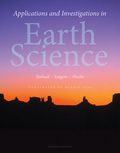
a.
Introduction:
The Lake Mead is the largest reservoir or storage of water in the United States with a very high capacity. The Lake has a length of 120 miles, depth of 532 feet and the surface area of 247 square miles. Lake Mead gives power and water to the people for over a large area because of high water capacity.
b.
To determine:
The changes that take place in Lake Mead since the year 1985.
Introduction:
The plate boundaries undergo more damage during the shifting of the tectonic plates. The pulling, colliding and shifting of the layers below the Earth’s crust can bring about more alterations in the geology of the plate boundary whereas, the interior of the plate experiences lesser fluctuations in the geological structure due to plate shifting.
c.
To determine:
The possible reason for the changes.
Introduction:
Lakes are small water bodies that are usually formed when the water accumulates in large craters. The lakes have abundant aquatic biodiversity and serve as a source of water for large human habitats. The lakes are also present in the forests and are the sole source of water for the animals living in the forests.
Want to see the full answer?
Check out a sample textbook solution
Chapter 3 Solutions
EBK APPLICATIONS AND INVESTIGATIONS IN
- how can the addition of nutrients such as nitrates and phosphates result in a reduction of the amount of dissolved oxygen in the water?arrow_forwardCongratulations! You have just been selected to be the ruler of China with absolute power! What are the first five things that you would do to protect the environment and human health from water pollution (not other types of pollution)?arrow_forwardWhy is storm water management more of a problem in an urban area than in a rural area?arrow_forward
- Think about natural resource management topics. Which topic or topics, if any, are of most interest to you?arrow_forwardWeathering, erosion, transportation, deposition Compaction, cementation, chemical actions (Lithification) Sediment Igneous rocks Cooling, solidification (Crystallization) Magma From mantle New material Melting added from depth (Metam Heat, inter Sedimentary rocks Metamorphic rocksarrow_forwardDiscussion Question: Essentials of Geography A+ Chapter 1 does a nice job introducing the Physical Earth Sciences with the traditional scientific methods and systems. However, Physical Geography exemplifies understanding spatial patterns. For example, we could research an area's cases of West Nile Virus using a table filled with location and number of deaths and it would be useful. However, an even better way to look at the information in order to search for an underlying pattern and an explanation would be to map the data. For the Chapter 1 Discussion, find a thematic map from your house, the Newspaper, the Internet, the textbook, or wherever you find one! Be sure to include the source such that any of us can get our hands on the same information/map. First DESCRIBE the patterns that you see. Then, INTERPRET the reasons for the pattern. For example,the figures above and below are maps with information plotted. Remember, descriptions are not arguable. Descriptions are factual…arrow_forward
 Applications and Investigations in Earth Science ...Earth ScienceISBN:9780134746241Author:Edward J. Tarbuck, Frederick K. Lutgens, Dennis G. TasaPublisher:PEARSON
Applications and Investigations in Earth Science ...Earth ScienceISBN:9780134746241Author:Edward J. Tarbuck, Frederick K. Lutgens, Dennis G. TasaPublisher:PEARSON Exercises for Weather & Climate (9th Edition)Earth ScienceISBN:9780134041360Author:Greg CarbonePublisher:PEARSON
Exercises for Weather & Climate (9th Edition)Earth ScienceISBN:9780134041360Author:Greg CarbonePublisher:PEARSON Environmental ScienceEarth ScienceISBN:9781260153125Author:William P Cunningham Prof., Mary Ann Cunningham ProfessorPublisher:McGraw-Hill Education
Environmental ScienceEarth ScienceISBN:9781260153125Author:William P Cunningham Prof., Mary Ann Cunningham ProfessorPublisher:McGraw-Hill Education Earth Science (15th Edition)Earth ScienceISBN:9780134543536Author:Edward J. Tarbuck, Frederick K. Lutgens, Dennis G. TasaPublisher:PEARSON
Earth Science (15th Edition)Earth ScienceISBN:9780134543536Author:Edward J. Tarbuck, Frederick K. Lutgens, Dennis G. TasaPublisher:PEARSON Environmental Science (MindTap Course List)Earth ScienceISBN:9781337569613Author:G. Tyler Miller, Scott SpoolmanPublisher:Cengage Learning
Environmental Science (MindTap Course List)Earth ScienceISBN:9781337569613Author:G. Tyler Miller, Scott SpoolmanPublisher:Cengage Learning Physical GeologyEarth ScienceISBN:9781259916823Author:Plummer, Charles C., CARLSON, Diane H., Hammersley, LisaPublisher:Mcgraw-hill Education,
Physical GeologyEarth ScienceISBN:9781259916823Author:Plummer, Charles C., CARLSON, Diane H., Hammersley, LisaPublisher:Mcgraw-hill Education,





